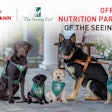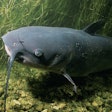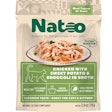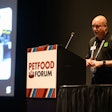
Pet food sensory analysis can give clues about which products will please both pets and their owners, said Kadri Koppel, PhD, assistant professor at Kansas State University, during her keynote address at the Petfood Innovation Workshop held in Kansas City, Missouri, USA on April 3, 2017.
“Consider sensory testing as one of the ways to figure out what pets and owners really like,” she told Petfood Industry. “I think that will help you along in your market success and your product success.”
How sensory analysis can help pet food companies
Pet food characteristics, pets’ reactions and owners’ observations make up a triangle of influences on whether a pet food succeeds in the market, she said. Smell, texture, taste and other sensations can determine if dogs and cats accept or reject a pet food. Similarly, the sensory characteristics of the pet food and its packaging influence pet owners’ perception of the food.
Beyond observing their pets’ responses to food, pet owners note physical characteristics of the pet food and its packaging that can have important repercussions, she said.
“Don’t change color of package,” advised Koppel. “Customers think, ‘I know I buy the yellow bag’ even if they don’t recall the exact variety.”
Once the package is open, some characteristics that pets may love can disgust their owners. For example, while dogs may be attracted to pungent odors, owners may be unwilling to tolerate that stink in their homes, she said.
Options for pet food sensory analysis
Larger pet food companies may have their own sensory laboratories, while other businesses work with independent labs. However, not all pet food companies have access to sensory analysis laboratories to determine the characteristics of their products. Those pet food companies can learn from published research and conduct their own in-house sensory analysis, Koppel told Petfood Industry.
For example, Koppel’s paper “An initial lexicon for sensory properties of dry dog food,” published in the Journal of Sensory Studies, defined sensory characteristics of pet food, such as barnyard, brothy, brown, grain, soy, vitamin, off-flavors, oxidized oil, cardboard and stale. Those standardized descriptive terms give pet food companies a common vocabulary to understand their products and their competitors'. The American Society for Testing and Materials also provides objective definitions for sensory characteristics.
“A major difficulty in sensory analysis of pet food is that testers need to be trained to be objective,” Koppel said. “It isn’t about human preferences. Panelists need to be trained to describe the characteristics of the pet food, not their subjective reaction to it.”
Once those characteristics have been determined, the results can help pet food companies understand what attributes influence pet preferences for one food or another when tests are conducted with animals.
Techniques for pet food sensory analysis
The most common pet food sensory analysis is done using a two-bowl test. Researchers present two products side by side and record animals’ preference for one over the other.
“Think about the objectives of the test first, then select the proper sensory testing methods to go about solving your sensory testing issues,” she said.
Currently, scientists are developing new methods to make testing more efficient and precise, said Koppel. In the competitive pet food market, the advancing science of sensory analysis can give brands an advantage.
Petfood Forum 2018
Koppel’s presentation at the Petfood Innovation Workshop was part of Petfood Forum 2017, an exclusive event serving pet treat and pet food manufacturers. At Petfood Industry’s 25th Anniversary edition of Petfood Forum, attendees learned about the latest in pet food research and marketing from speakers including Randi Zuckerberg and Temple Grandin.
Petfood Forum 2018 will take place at the Kansas City Convention Center in Kansas City, Missouri, USA on April 23 -25 , 2018.


















